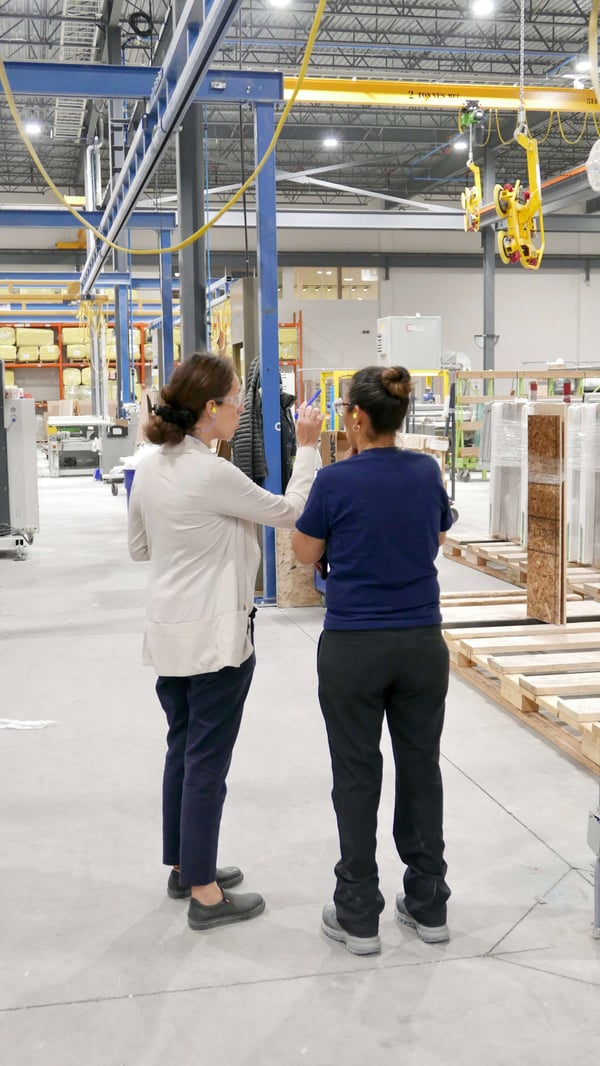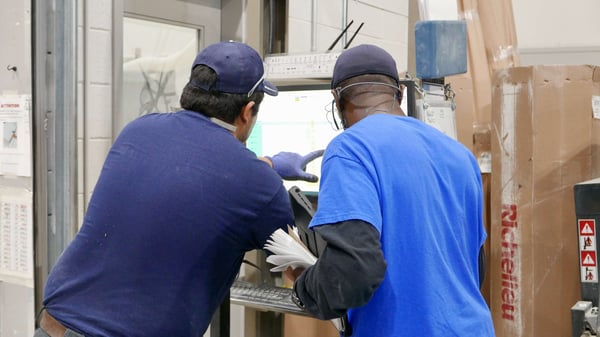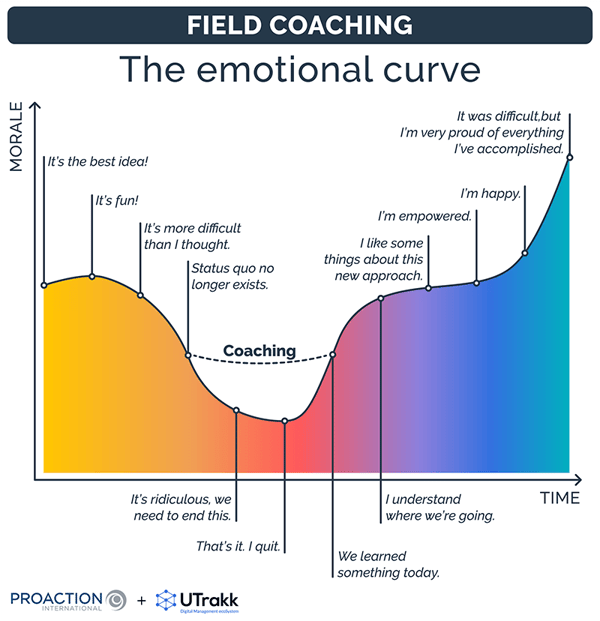Immerse yourself in the customer's reality
Arriving early that morning, Angélique greets us as she answers a few emails before starting her day. "I always try to arrive for the morning kick-off. It's something we've set up with the managers, a 10-15 minute launch of the day with the employees."
Quickly, we make our way to the rallying point for the day's first meeting. Angélique's eyes light up with pride as soon as we tell her about the Moderco project: "I developed the project from A to Z with them, so we spend a lot of time together, and I love working with them."
Denis, the production coordinator, leads the kick-off meeting with his team. Angélique stays in the background and observes him, taking notes so that she can give him feedback after the meeting.
As we'll see throughout the day, observation at the point of execution, the cornerstone of Gemba Walk, is one of the critical elements of field coaching. Here, it enables Angélique to observe Denis in his work environment and interactions with his employees in real-time.
Later, Angélique explains the difference between field coaching and the more widely known executive coaching:
Executive coaching works mainly on posture and mindset. It's more focused on decision-making, global vision, and objectives. On the other hand, field coaching requires much more connection with technical and operational control points and must be adapted to each line. It also focuses more on supporting local managers to adopt proactive performance management behaviors, be capable of resolving discrepancies, and become coaches and resources for their employees.
The production day is launched once the kick-off is over and the employees' priorities have been set. Angélique can begin a first round of active supervision with Vicky, a production supervisor. Both have done their homework beforehand.
"Both coaches and coachees need to get in shape for the day, but in a different way. Coaches and Proactors* consult UTrakk to look at the points of vigilance and the strengths to prepare for coaching. Before starting the tour, the supervisor is reminded of these points to ensure they know what needs to be worked on. It's also essential to validate the issues and priorities of the moment to adapt to the reality on the ground. The preparation and the pre-tour briefing are crucial, as they enable us to get off to a good start rather than proceeding haphazardly."
*Proactors are in-house employees trained by Proaction International to take over once the mandate is over, perpetuating what has been learned and good practice.
Vicky and Angélique enter the factory and begin their tour. In the field, the coach observes all aspects of technical and relational interaction between the manager and his team members. Between each shift, the coach checks with the coachee to see if there are any areas for improvement.
This approach, known as "shadowing", can seem invasive and takes some getting used to.

Some people don't like to be shadowed and will say so in a straightforward way, explains Angélique. But as soon as they get the hang of it and understand the added value of coaching, it doesn't bother them anymore. Some even like it and ask to be accompanied on tour because they can see what it can do for them. Hence, it is essential to give positive feedback to encourage players to improve.
"Another critical point is that we work with people. Sometimes, the time must be corrected, or specific issues are at stake. So, it's imperative to be discerning and open-minded as a coach. If it's not a good day for the person(s), you must be flexible and postpone the session. It is something the coachee will appreciate. Coaching should be a support, not an added burden."
After the tour, the coach provides feedback on the tour to highlight the manager's strengths and areas for improvement. After this interview, the manager should clearly understand what they have done well and what can be improved.
Vicky, who has been working at Moderco for five years and has recently been promoted to management, loves having this outside view:
I'd never been coached before. This approach has enabled me to run around the floor less to put out fires. I'm more organized and structured in my work. I also find it reassuring to have an outsider. It brings another vision, another point of view. You can't see yourself in the heat of the moment when you're working. The coach allows us to observe what's going well and what's not.
As we leave Vicky to continue her work in the factory, we head with Angélique to Denis' office, seen earlier at kick-off. A Moderco employee for 20 years, he is now a production coordinator. He oversees production planning, a key position in any manufacturing company.
Then, it's time for the active supervision review with the coordinator. It's a roadshow, but at a higher level, the coach or consultant checks with his supervisors, who have done the rounds beforehand to see the morning's issues. The escalation of these issues, progress, and status is crucial.
Then comes the production review, during which the operations manager, supported by the coordinator, passes on production issues to the support teams (maintenance, procurement, reception, quality, etc.), as well as the status of the sectors. The escalation of problems and actions from the shop floor to all plant functions can then be observed.
Later, Angélique tours again and coaches the Proactor. Several other reviews and tours follow. When the consultant has time, she also works collaboratively on planning. She creates intervention groups to fine-tune cadences, such as improving tour content.

Practice makes perfect
In general, a complete field coaching approach takes six months to complete. It gives sufficient time for in-depth work and for the acquired skills to become reflexes. It also gives managers time to see significant improvements in their day-to-day work. Not only do they have to adapt, but they also have to experience what is known as the "emotional curve".

"At first, coachees are often open and enthusiastic about implementing a new approach. But motivation drops when they realize that it involves them too, that they're the ones we're going to coach, and that they have changes to make. They can become discouraged. So it takes a period of adjustment for the coachees to go through the different phases of the curve before they adapt, accept the approach, and change their behavior," says Angélique.
Measuring progress with KBIs
Key behavioral indicators (KBIs) are not limited to assessing the impact of a coaching plan. They play an essential role in the project's trajectory, enabling us to monitor the evolution of management skills closely. They allow us to observe changes in the players' behavior, skills, and managerial practices. By providing a clear view of strengths and areas for improvement, they help adjust strategies accordingly.
The UTrakk daily management system takes this further by supporting managers during and between key management activities (field rounds, meetings, etc.) while offering coaching functionalities and tracking key behavioral indicators.
Supporting managerial development: The central role of field coaching
Field coaching is a key element of success in the manufacturing industry. In sports, the coach is there to observe, advise, and guide the manager at every moment of the working day. They provide personalized support to help managers develop their operational and managerial skills.
The benefits of field coaching apply not only to managers and their teams on a professional and personal level but also influence the whole organization (production, operational, etc.), rather like a domino effect. Everyone benefits.
There's no denying it. I hear managers talking about it often and can see the results. The advantage is that the coached people can become aware of their evolution and progress; it transforms them. It's not just the process we're changing; it's the workers too.










